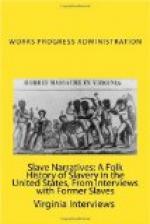“Clothes? yes’m. We had two suits of clothes, a winter suit and a summer suit and two pairs of shoes, a winter pair and a summer pair. Yes’m, my mammy, she spin the cotton, yes’m picked right on the plantation, yes’m, cotton picking was fun, believe me! As I was saying, Mammy she spin and she wears the cloth, and she cut it out and she make our clothes. That’s where I git my taste to sew, I reckon. When I first come to Baltimore, I done dressmaking, ’deed I did. I sewed for the best fam’lies in this yere town. I sewed for the Howards and the Slingluffs and the Jenkinses. Jest the other day, I met Miss C’milla down town and she say. ’Alice, ain’ this you? and I say, ‘Law me, Miss C’milla’, and ’she say, ’Alice, why don’ you come to see Mother? She ain’ been so well—she love to see you....’
“Well, as I was a saying, we didn’t work so hard, them days. We got up early, ’cause the fires had to be lighted to make the house warm for the white folks, but in them days, dinner was in the middle of the day—the quality had theirs at twelve o’clock—and they had a light supper at five and when we was through, we was through, and free to go the quarters and set around and smoke a pipe and rest.
“Yes’m they taught us to read and write. Sunday afternoons, my young mistresses used to teach the pickaninnies to read the Bible. Yes’m we was free to go to see the niggers on other plantations but we had to have a pass an’ we was checked in an’ out. No’m, I ain’t never seen no slaves sold, nor none in chains, and I ain’t never seen no Ku Kluxers.
“I live with the Wakefiel’s till I was ‘leven and then Marse Wakefiel’ give me to my young mistress when she married and went to North Carolina to live. And ’twas in North Carolina that I seed Sherman, ’deed I did! I seed Sherman and his sojers, gathering up all the hogs and all the hosses, and all the cows and all the little cullud chillen. Them was drefful days! These is drefful days, too. Old man Satan, he sure am on earth now.
“Yes’m, I believes in ghos’ses. I ain’t never seed ’em but I is feel ’em. I live once in a house where a man was killed. I lie in my bed and they close in on me! No’m, I ain’t afraid. The landlord say when I move out, ‘you is stay there longer than anybody I ever had.’ ’Nother house I live in (this was in North Carolina too), it had been a gamblin’ house and it had hants. On rainy nights, I’d lie awake and hear “drip, drip ... drip, drip....” What was that? Why, that was the blood a dripping ... Why on rainy night? Why, on rainy nights, the blood gets a little fresh...!”
Maryland
Sept. 4, 1937
Rogers
Perry Lewis, Ex-slave.
Reference: Personal interview with Perry Lewis,
ex-slave,
at
his home, 1124 E. Lexington St., Baltimore.
“I was born on Kent Island, Md. about 86 years ago. My father’s name was Henry and mother’s Louise. I had one brother John, who was killed in the Civil War at the Deep Bottom, one sister as I can remember. My father was a freeman and my mother a slave, owned by Thomas Tolson, who owned a small farm on which I was born in a log cabin, with two rooms, one up and one down.




